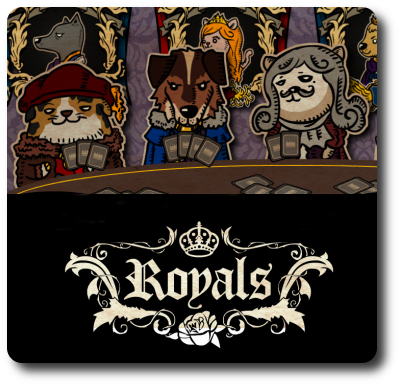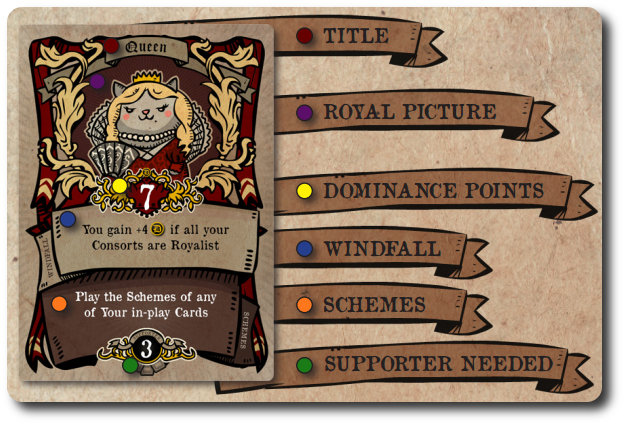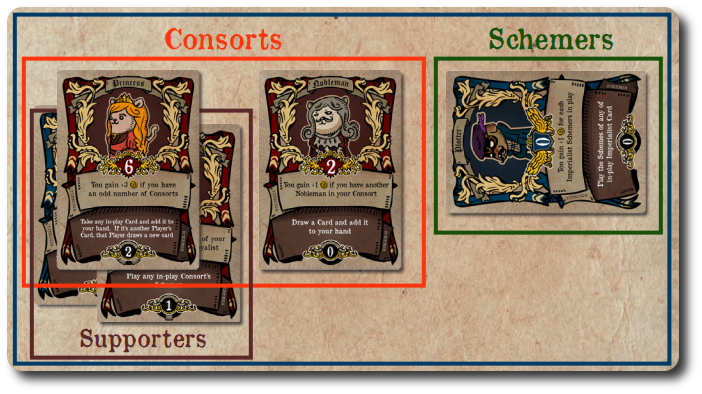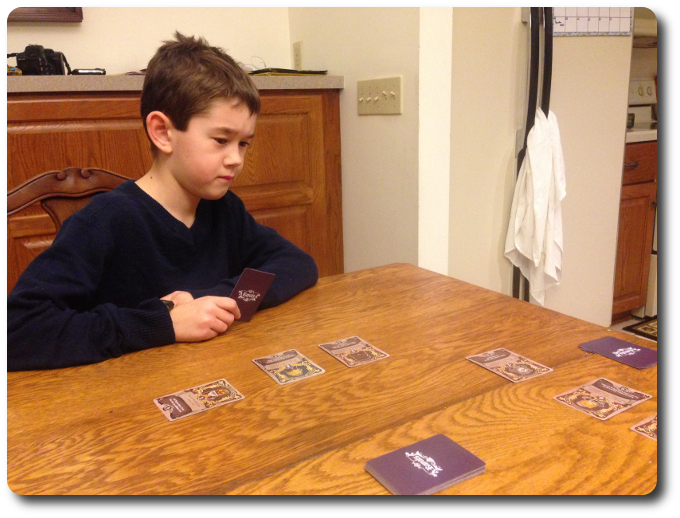
The Basics:
- For ages 9 and up (publisher suggests 12+)
- For 2 to 4 players
- Approximately 15 minutes to complete
Geek Skills:
- Counting & Math
- Logical & Critical Decision Making
- Reading
- Pattern/Color Matching
- Strategy & Tactics
- Risk vs. Reward
- Hand/Resource Management
Learning Curve:
- Child – Easy
- Adult – Easy
Theme & Narrative:
- Scheme your way to political power!
Endorsements:
- Gamer Geek mixed!
- Parent Geek mixed!
- Child Geek mixed!
Overview
William Shakespeare wrote “Uneasy lies the head that wears a crown.” If that’s true, then you’ll be doing the current monarch a favor by removing it. In fact, that’s exactly what you plan to do, but you cannot do it alone. To gain power and eventual dominance at court, you’ll need followers to publicly back you. Behind closed doors, you’ll need to deal with schemers and rouges. If you keep your wits about you, the crown could be yours!
Royals, designed by Jackson Lin and published by Level 32 Studio via the Game Crafter, is comprised of 34 cards. The cards are made of standard cardstock and durable. The artwork by Mr. Lin is simply excellent. Each card is well illustrated and colorful. It’s worth noting that this game was a finalist in the Micro Game Challenge hosted by the Game Crafter and sponsored by All Us Geeks and Father Geek.
Game Set up
To set up the game, first shuffle all the cards.
Second, deal to each player 5 cards, face-down. Players should look at their cards, but keep them hidden from their opponents until played.
Third, place the remaining cards, face-down, in the middle of the game playing area. This is the draw deck. Leave room next to the draw deck for a discard pile.
That’s it for game set up. Time for some political intrigue.
A Court of Cats and Dogs
The cards in Royals represent influential individuals who play a game of dangerous intrigue at court. Instead of people, cats and dogs are used. The species of the animal, however, plays no part in the game. What does is the animal’s political ideology.

There are two factions at court who are mustering support to obtain dominance. These are the Royalists (red card background) and Imperialists (blue card background). While both groups can work together, the final scoring might or might not be impacted by the number of cards of each type the player has.

Each card can be played 1 of 3 different ways.
- Consort: When played as a Consort, the card is placed, face-up, in front of the player. Consorts will award Dominance points at the end of the game and possible bonus points referred to as a “windfall”.
- Consort Supporter: Some Consorts might need a bit of support before they are willing to make their political views publicly known. Each card has a Supporter value noted at the bottom. This indicates the number of cards that must be played with it if the card is played as a Consort. Consort Support cards do not provide anything other than political and emotional support, allowing the Consort to brave the ridicule of the court. Consort Support cards might or might not provide additional Dominance points at the end of the game.
- Schemer: Not every attendant at court, in the city, or the surrounding area is eager to let their political ideology be known. Any card can be played as a Schemer that allows the player to use it for an immediate action. However, Schemers do not provide Dominance or windfall points.
A Game of Royals
Royals is played in turns with no set number of turns per game. On a player’s turn they will take one of the following action options.
Note: A player MUST play at least 1 card per turn, even if the card they are forced to play would harm their final score or not have any direct effect on the game. If a player ever runs out of cards, they are out of the game until the final scoring takes place.
Option 1: Play a Consort
The player selects 1 of their cards from their hand and plays it, face-up, in front of them. If the card requires Consort Supporters, the player also places the number of cards indicated underneath the card they are playing. The Consort Supporters need not be the same animal species or faction as the Consort. Any newly played Consorts and their supporters should be kept apart from any previously played Consorts and Schemers.
Option 2: Play a Schemer
The player selects 1 of their cards and places it to one side of their playing area sideways and face-up. The player then reads and completes (if possible) the action described in the card’s Schemes area. Any newly played Schemers should be kept apart from any previously played Consorts and Schemers.

This concludes the player’s turn. The next player now takes their turn.
Closing Court
The game continues until all the cards the players have in their hand are on the table. Each player now determines their final score by adding up the following values:
- Add all Dominance point values from Consort cards (not from Consort Supporters or Schemers unless the card specifically states it should be included)
- Add all bonus windfall points (depending on the windfall, Consort Supporters, Schemers, and factions will impact the windfall point values)
The player with the most points wins the game.
Game Variant
For a longer game, deal to each player 6 or 7 cards at the beginning of the game.
House Rule
Royals calls for players to determine the winner after a single game. All our players found that to be silly. It was like saying the winner of a Poker game was based on the first and only hand. As such, we implemented a house rule that each game winner was determined by either counting up all the points after 3 games or the “Best Out of Three” for 2-player games.
To learn more about Royals, see the game’s web page on the Gamer Crafter.
Prediction
Royals would appear to be a very easy game to teach and to learn. The only aspect of the game that has me concerned is the limitation of actions. What a player can or cannot do is based on their cards. Sometimes games where the cards dictate the actions the players can or cannot take can hold a player back. Or, even worse, make them feel like they have no way to develop a strategy. Everything is reactionary to cards that tell the player exactly what they can do. If this is the case with Royals, I imagine we’ll see players who are upset with the game play. Some might be upset enough to consider the game “broken”.
Teaching Royals is very simple. I suggest you give an example of a Consort, its supporters, and a Schemer. Make sure you show that they are kept together in groups and make it a point to note how windfalls work. You should also mention (more than once) that a player MUST play a card every turn. Once they are out of cards in their hand, they are out of the game until it ends. The point to make here is that players should focus on hand management. That’s about it, as far as the game goes. Note that players will need to know how to read to play Royals.
And so, after teaching the game to my oldest little geek, I asked him his thoughts on Royals so far.
“I like games where cards can be used for multiple things. Let’s play!” ~ Liam (age 9)
So do I. It makes a simple hand of cards into the equivalent of a Swiss Army knife. Lots of possible tools and tactics to explore. Let’s play Royals and see if we have fun or we find the game to be a royal pain.
Final Word
The Child Geeks very quickly understood how the play the game, but not how to play it well. Royals is a game about playing cards at just the right time to maximize each card’s effect. Each player is at first limited by the number of cards they have in their hand. Through smart game plays, they can obtain more, but luck also plays a large part in the game. Sometimes the Child Geeks played all their cards right upon review, but there was simply no way they could have won the game. Other times, some Child Geeks had the worst cards possible and just couldn’t muster enough effects and actions to be competitive. As you can imagine, this created a great deal of frustration for the Child Geeks. According to one Child Geek who was dealt a particularly bad hand, “This game is really frustrating.” When I suggested that players determine the winner by tallying up the scores after 3 games, this alleviated a number of the Child Geek concerns who were not happy with a single game determining the winner. Sadly, even this change was not enough to satisfy all of the Child Geeks and the endorsement for Royals was mixed. Half of our Child Geeks loved it, despite not being able to win, and the other half despised it because the game sometimes never gave them the chance. One Child Geek said, “It’s a good game, but sometimes you just can’t win no matter how good a player you are.”

My little geek frowns as he tries to figure out how he can beat my score with only 1 card left to play!
The Parent Geeks found Royals to be a fun and casual game, both with their family and with their peers. They enjoyed the challenge of attempting to maximize their points, but they also felt that the cards they were dealt at times limited their ability to compete. According to one Parent Geek, “The most frustrating thing about this game is that it puts you in the corner sometimes.” At which point, the majority of the players quoted Dirty Dancing. Again and again, I observed that a few hands dealt to a player were simply not going to do well against other players. Honestly, I saw a lot of bad card plays, too. In the end, all the Parent Geeks thought Royals was a good game, but a being dealt a bad hand made things feel horrible. Really, no different from most card games, but there is very little a player can do at times to fix a broken hand. Half the Parent Geeks voted to approve the game and highly suggested that the winner of the game always be determined by “Best Out of Three”. The other half voted to play something else. Playing a longer game seemed to reduce the odds of being dealt a bad hand, but the longer game length as a result was not well received.
A few of the Gamer Geeks became very fed up with Royals right from the start. According to one rather angry Gamer Geek, “This is ****ing stupid! I can’t do anything with these cards!” At which point, the rest of the players laughed at him, mocking his misery, because that’s what good friends do. The very next game, the same player was dealt a good hand and did very well. After 3 games, one of the Gamer Geeks said, “A player can’t really do anything about a bad hand. They can’t discard and draw new cards unless they have a card with that action. This means that some players will never win.” If a Gamer Geek felt he could not win, he did all he could to make the rest of the player’s have a horrible time winning points, which was pretty fun. In the end, the Gamer Geeks observed that much depended on luck and the hands were very inconsistent. Some of the Gamer Geeks didn’t care and thought what was being observed was nothing more than randomness. Others felt it revealed a shortcoming in the game design. The end result was a mixed level of endorsement from the Gamer Geeks.
For the first time, I am in disagreement with all 3 of our groups. I didn’t find Royals to be “broken” whatsoever. In fact, I found the game to be fast and engaging. True, there were times I was dealt a hand that I knew I couldn’t win the game with, but that didn’t stop me from trying. Nor did it stop me from doing all I could to reduce the points for some players to ensure they didn’t win the game. That’s a different kind of fun, admittedly, but I enjoyed it. What I think many of our group members considered as a “game design fault” is nothing more than the result of being dealt a bad hand.
More than anything else, Royals challenges a player to look at the cards they were dealt and then do the best they can with them. At a glance, this might seem to be nothing more than playing some cards as Consorts and others as Schemers, but look again. Windfalls give additional points if a player has a certain number of factions in play or an opponent doesn’t. This creates some interesting strategies and will oftentimes change during a single game. If a player watches their cards, they should be able to play them to obtain a large number of points. Of course, they are capped by what cards they have and are at the mercy of their opponents’ cards.
I found Royals to be a game worth playing and I enjoyed it. I’m keeping it in my collection and there’s always time to play a hand or two. For such a small game, it brings a lot of fun to the table…as well as frustration. But that can be easily fixed with a quick shuffle, a fresh hand, and a new chance to win.
This game was given to Father Geek as a review copy. Father Geek was not paid, bribed, wined, dined, or threatened in vain hopes of influencing this review. Such is the statuesque and legendary integrity of Father Geek.




Thank you for the helpful and well-thought review. Hope it brings some enjoyment to you.
Like most card game, luck do play a major factor. What you do with the cards do matter too. In playtesting I often found that you could have a entire different outcome, with the same hand, if you play it in a different combination. This make cards that allow you to peek other player’s hand pretty useful to play at an advance level. However, some hand are still weaker to other.
But here are also 2 variations if looking for some different plays.
“All Seeing” – Instead of having the cards in hand, they are lay out face-up, so any player could see each other’s cards. This allow them to formulate better strategy, counter strategy, and meta strategy earlier.
“Draft Mode” – Not for beginner. Instead of dealing out cards, Place 5 card out at the time, and have each player pick. Once the cards are picked clean, place 5 more out (for 3-4 players), till all player have 5 cards in hand. This allow them to formulate and create a strategy early one.
See if those variation will help add on the game (and fun). Enjoy, and keep up the good works.
Interesting game variants! Sadly, they were not included with the game rules, so I never had a chance to try them out.
Pingback: Today in Board Games Issue #126 - Today in Board Games